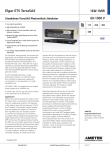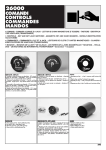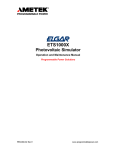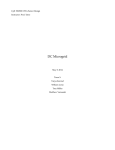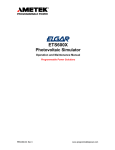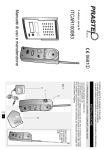Download Elgar ETS TerraSAS 1kW
Transcript
Elgar ETS TerraSAS 1kW-1MW 60 V Standalone TerraSAS Photovoltaic Simulator • Low output capacitance 115 • High bandwidth up to 800Hz • High resolution I-V curve simulates static and dynamic conditions 208 400 480 • Designed for high speed Maximum Power Point Tracking (MPPT) • Can be integrated into a multi-channel system for higher power testing • Energy Harvest and Oscilloscope measurements built in • Low voltage, high bandwidth version for DC Power Optimizers For microgrids, energy storage, and inverter test applications, the TerraSAS™ series photovoltaic (PV) simulators are specifically designed to emulate the dynamic electrical behavior of a terrestrial PV solar array. They offer low output capacitance and high closed loop bandwidth to keep up with the advanced Maximum Power Point Tracking (MPPT) algorithms used in today’s grid-tied inverters. The ETS Embedded TerraSAS is a high performance solution in a small form factor that combines an agile power supply with an innovative I-V curve generator in a single standalone unit. • ETS1000: For non-isolated string inverters up to 1000Vdc Voc. • ETS600: For use with string inverters that contain transformer isolation up to 600Vdc Voc. • ETS80: For use with micro-inverters or DC optimizers up to 80Vdc Voc Application Many solar inverters generate AC ripple on their DC input, which is connected to the photovoltaic array. For single phase inverters, the frequency of this ripple is twice the line frequency (120 Hz for US models). The simulator’s power supplies must not suppress this ripple as a function of their regulation loop. An increasing number of inverters (and virtually all micro-inverters) accurately measure amplitude and phase of the ripple voltage and current to quickly track the MPP of the array. This approach allows tracking the MPP at a much higher speed when compared to conventional dithering techniques (also called perturbate-and-observe). Faster tracking of the 858.458.0223 MPP results in a much higher overall efficiency in cloudy conditions, where the irradiance is constantly changing. It is likely that all solar inverters will use this approach in the near future, since end users are very sensitive to the overall efficiency of their solar energy installations. To satisfy this requirement, the PV simulator must be capable of reproducing the voltage / current behavior of a solar array at the ripple frequency. Most standard switching power supplies employ very large output capacitors and inductors in their output circuits and are unable to deliver the required performance - regardless of the response speed of the I-V curve controller. Elgar’s TerraSAS line of PV simulators are based on high speed versions of our standard products, where output capacitors and other speed-limiting components have been adjusted. This results in a speed improvement of 10 times or better. Proprietary features built into the PV controller hardware and firmware, combined with our high speed power supplies, deliver the required performance. This technology was extensively tested on micro-inverters and is ready to test the next generation of inverters. The required performance is delivered by high speed switching power supplies and advanced DSP signal processing techniques. In some conditions traditional DC power sources using IGBT technology do not meet MPPT response speed requirements, depending on the MPPT principles. Our power supplies use Power MOSFETs, which typically switch ten times as fast as the most recent IGBTs. Higher switching frequency translates to smaller output capacitors and inductors - which is the key to a successful high speed power supply design [email protected] AMETEK Programmable Power 9250 Brown Deer Road San Diego, CA 92121-2267 USA 09052012 1 ETS TerraSAS Product Overview The ETS series standalone TerraSAS consists of a programmable DC power supply with control software and GUI interface, output isolation, and a unique PV simulation engine that provides the I-V curve. This combination of hardware, software, and firmware allows the TerraSAS to simulate test protocols or combinations of events that a real-world solar installation will be subjected to. The included software allows modeling of a PV panel without an extensive knowledge of solar array parameters. The only parameters required for a simulation are the open circuit voltage (Voc), short circuit current (Isc), and the peak power parameters Vmpp and Impp. Changes to these parameters allow the shape of the I-V curve to be adapted to any fill factor between 0.5 and 0.95. Once an I-V curve has been generated, changes to the irradiation level or temperature can be modified on the fly to test the behavior of a grid tied inverter under realistic conditions for cloud shadowing and panel temperature rise. Long term weather simulations can be loaded and run to determine the amount of energy harvest delivered in a given situation. Inverter designers use these accuracy and efficiency tests to optimize real MPP search modes. Scalability Power supplies are available in 850W, 5kW, 10kW, and 15KW increments. The 80V units are available in two power levels: 1200W for microinverters and 850W for DC power optimizers. The bandwidth on the 850W version has been improved to 2kHz by adding a linear regulation output stage. 600V units are available in 5kW, 10kW, and 15kW versions depending on Isc requirements. 1000V units are available in 5kW and 10kW versions depending on Isc requirements. All versions are easily connected in parallel to scale output power up to handle microinverters, string inverters, and even utility scale inverters. Many models can also be connected in series to handle higher voltage tests. Please refer to the connection diagrams located in the User Manual and follow appropriate wiring codes before connecting ETS PV simulators in series or parallel. 2 Real time I-V curve display The Elgar Real time I-V curve display is updated 20 times per second to illustrate dynamic inverter behavior (operating point and sweep amplitude). Compared to other commercially available solar array simulators with an update rate of only 1Hz, this allows more accurate analysis of the inverter’s actual MPP tracking ability. www.ProgrammablePower.com ETS TerraSAS 1kW-1MW Basic I-V Curve simulation 1. Create and add a curve 2. Drag and drop this curve onto the channel tile 3. Click the ON/OFF button on the channel tile to execute curve Basic I-V Curve simulation The Elgar TerraSAS user interface is intuitive, graphically colorful and simple to learn. I-V curves are created by entering simple parametric data or by importing data from the Sandia TAM database. It is not necessary to use Java Script or any other Script hosting to create an IV curve and execute it. Dynamic Irradiance profile display The Elgar TerraSAS profile display of Irradiance and temperature is unique and innovative. It enables inverter designers to easily load and implement standards based cloudy condition scenarios, such as the weighted efficiency measurements called out in EN50530 or California Energy Commission. The ability to model dynamic performance profiles allows complex test validation in any situation in a repeatible, reliable manner. These standard profiles are impossible to simulate with a real array. It can also be controlled to a very fine degree and real profiles can be entered and run from actual speed to 100 times actual speed for accelerated lifecycle tests. TerraSAS dynamic irradiance profile display 858.458.0223 [email protected] 3 ETS TerraSAS - Specifications Photovoltaic array modeling This feature allows the user to quickly define an array of PV panels connected in series or parallel. Using this array modeling capability, the user can simulate such real world conditions as mismatched panels, which result in multiple hump I-V curves. It is important to verify that the MPPT algorithm finds and settles on the universal MPP, not a local maximum. Photovoltaic array modeling Import module data from embedded Sandia database and create I-V Curve Build the array model by binding to the desired curve and specifying the array size The effects of shadowing, aging and faulty modules can be previewed in real time. the resulting I-V curve can be dragged and dropped to any output for inverter testing. Specifications 4 Model Number ETS60 ETS80 DCS80-PV ETS600 ETS1000 Output voltage, Voc (V) Output current, Isc (A) Output power @ 0.85FF (W) MPP tracking speed (Hz) I-V curve resolution (# of pts) Output isolation (Vpk) Available I/O 60 14 714 2000 1024 +-600 Ethernet 80 10.5 714 2000 1024 +-600 Ethernet 80 15 1020 120 1024 +-160 Ethernet 600 8, 17, 25 12750 200 1024 +-600 Ethernet 1000 5, 10 8500 200 1024 +-1400 Ethernet Remote sense 10V 10V 10V 10V 10V Input voltage, AC 120/230 (operational range 100-250 Vac) 120/230 (operational range 100-250 Vac) 120/230 (operational range 85-265 Vac) 208/220 VAC (operating range 187 242 VAC) 380/400 VAC (operating range 342 440 VAC) 440/480 VAC (operating range 396 528 VAC) 47-63 Input frequency, Hz 47-63 47-63 47-63 208/220 VAC (operating range 187 242 VAC) 380/400 VAC (operating range 342 - 440 VAC) 440/480 VAC (operating range 396 528 VAC) 47-63 Power factor > 0.9 typical > 0.9 typical > 0.9 typical > 0.9 typical > 0.9 typical Output noise < 0.6 Vpp measured across a 1μF capacitor at the end of a 1.8m (6ft) line at full load. < 1 Vpp measured across a 1μF capacitor at the end of a 1.8m (6ft) line at full load. Operating temperature 0-50 degs C < 0.6 Vpp measured across a 1μF capacitor at the end of a 1.8m (6ft) line at full load. 0-50 degs C 0-50 degs C < 2 Vpp measured across a 1μF capacitor at the end of a 1.8m (6ft) line at full load. 0-50 degs C < 0.6 Vpp measured across a 1μF capacitor at the end of a 1.8m (6ft) line at full load. 0-50 degs C Physical dimensions • 17.5 x 1.7 x 19.0 inch • 445 x 43.6 x 483 mm • 19 lbs (8.6 kg) • 17.5 x 1.7 x 19.0 inch • 445 x 43.6 x 483 mm • 19 lbs (8.6 kg) • 20.4 x 1.7 x 19.0 inch • 518 x 43.6 x 483 mm • 23 lbs (10.5 kg) • 25.46 x 5.25 x 19.0 inch • 64.7 x 13.3 x 48.3 cm • 5kW 40 lbs (18 kg) • 10kW 60lbs (27kg) • 15kw 80lbs (36kg) • 25.46 x 5.25 x 19.0 inch • 64.7 x 13.3 x 48.3 cm • 5kW 60lbs (27kg) • 10kw 80lbs (36kg) Regulatory Certified to UL/CSA 61010 and IEC/EN 61010-1 www.ProgrammablePower.com




